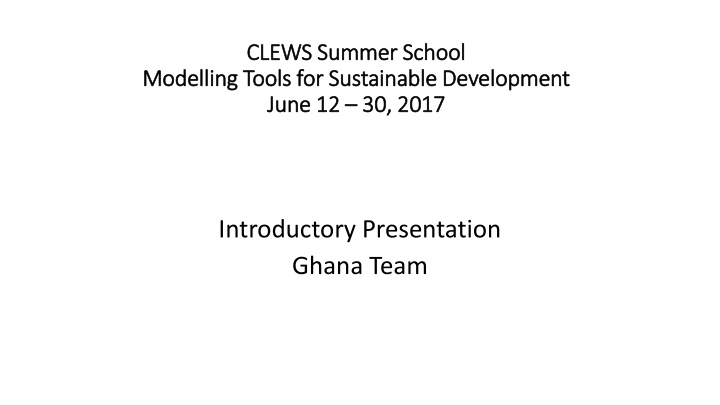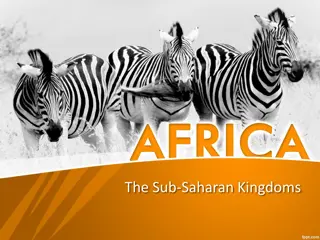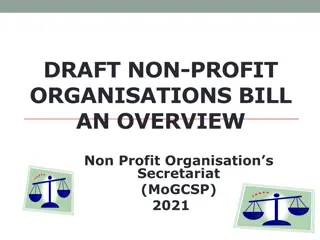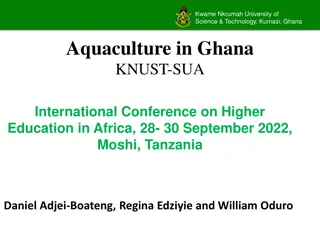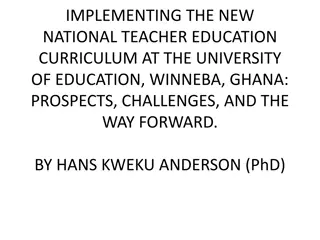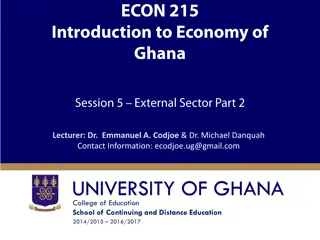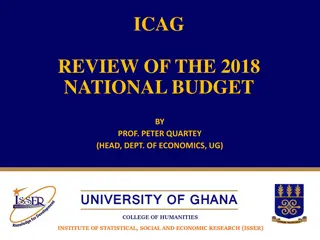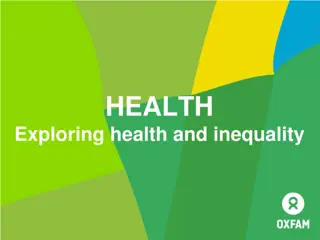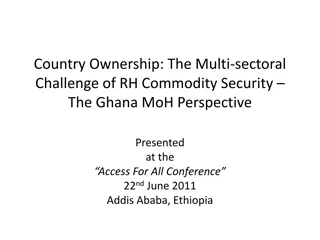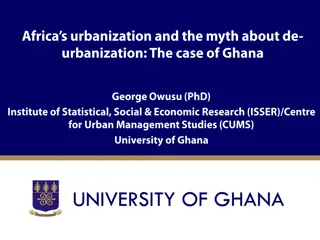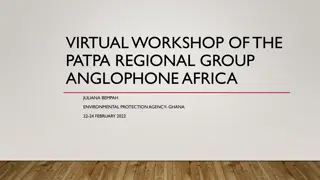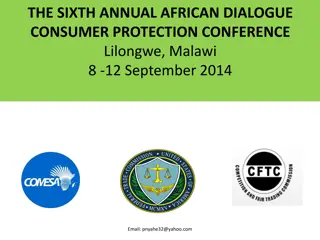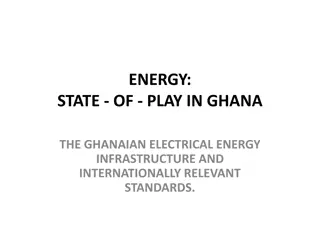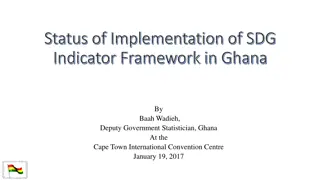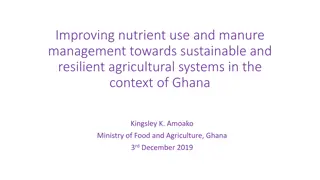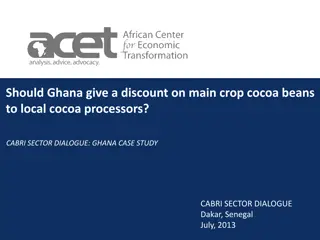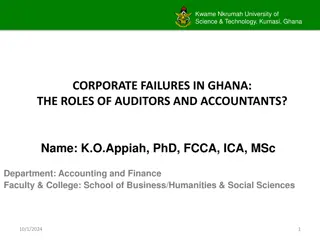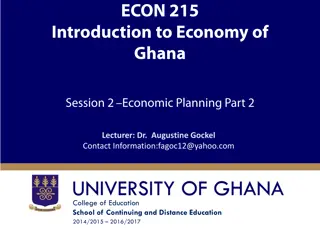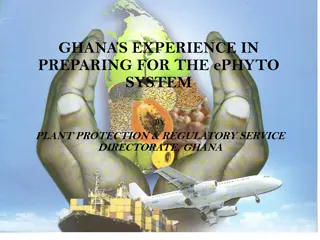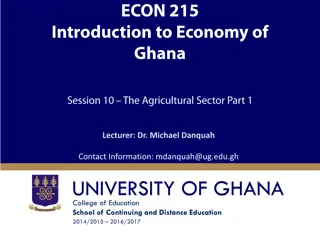Sustainable Development in Ghana: Environmental Challenges and Opportunities
Ghana faces environmental challenges such as erosion, deforestation, and water scarcity, but also has abundant natural resources like gold and oil. The country's diverse climate and topography present both risks and opportunities for sustainable development.
Download Presentation

Please find below an Image/Link to download the presentation.
The content on the website is provided AS IS for your information and personal use only. It may not be sold, licensed, or shared on other websites without obtaining consent from the author.If you encounter any issues during the download, it is possible that the publisher has removed the file from their server.
You are allowed to download the files provided on this website for personal or commercial use, subject to the condition that they are used lawfully. All files are the property of their respective owners.
The content on the website is provided AS IS for your information and personal use only. It may not be sold, licensed, or shared on other websites without obtaining consent from the author.
E N D
Presentation Transcript
CLEWS Summer School CLEWS Summer School Modelling Tools for Sustainable Development Modelling Tools for Sustainable Development June 12 June 12 30, 2017 30, 2017 Introductory Presentation Ghana Team
Basic Information - Ghana Land Area 238,539 km2 Water bodies 3,275 km2 Coastline 539 km Total population 28.3 million (2016) Population growth rate 2.1 % Currency: Ghana cedis (1 USD = 4.2 Ghc) GDP (current prices) US$ 42,676 million (in 2016) GDP per capita US$ 1,507 (2016) Natural resources: Gold, Diamond, oil
Sustainable Development Background Climate There are 5 main agro-ecological zones: These are Rain Forest, Deciduous Forest, Transitional Zone, Coastal Savanna and Northern Savanna (Guinea and Sudan Savanna). Rainfall Highest in South-western (2,000 mm/yr), north (950 mm/yr) and south-eastern (800 mm/yr).
Sustainable Development background Topography The topography is predominantly undulating, with slopes less than 1%. Even though the slopes are gentle, about 70% of the country is subject to moderate to severe sheet and gully erosion. Temperature Average maximum temperatures are highest between February to April (320 C) in the southern zone whiles that for the northern zone occurs from April to May (340C).
Land use Settlements land cover class. From 1,460 sq km in 1975, urban areas expanded to 3,830 sq km in 2013 representing 161% increase over 38 years. Agricultural land use increased from 13% of Ghana total area 1975 to 32% 2013. Savannas experienced a large loss, from about 51 to 40 percent of the total land area from 1975 to 2013 The forest class (represented primarily by Ghana s dense evergreen rain forest and moist deciduous forest) shows a small decline in area from about 16,400 sq km in 1975 to 12,400 sq km in 2013
Water Availability and use Surface water resources Volta system: four main rivers (Red, white, black and Oti) make up 70% of surface water resources. South-Western system: (Bia, tano, ankobra and pra) make up 22% of surface water resources. Coastal system: (Tordzie, Aka, Densu, Ayensu, Ochi-Nakwa and Ochi-Amissah) make up 8% of surface water resources.
Water Supply Rural Water Coverage Urban Water Production 400 349.3 70 64.5 350 % of targeted population served 60 300 million cubic meters 52.9 50 250 211.7 40 200 30 150 20 100 10 50 0 0 2006 2007 2008 2009 2010 2011 2012 2013 2014 2015 2006 2007 2008 2009 2010 2011 2012 2013 2014 Community water supply (% of targeted population served mainly through boreholes) increased from 52.9% to 64.5% Treated water production increased from 211.7 million m3in 2006 to 349.3 million m in 2016. Coverage rate is 76% in 2015
Energy Resource Solar Wind No . Site Name Location Monthly Average Wind Speed @ 60m (m/s) 1 Ekumfi Edumafa Mfantsiman Municipality, Central Region 4.67 2 Gomoa Fete GomoaEast District, Central Region 4.53 3 Avata Ketu South Municipality, Volta Region 5.01 4 Sege/Ningo Dangme West District, Greater Accra Region 5.46 5 Atiteti/Dzita Keta Municipality, Volta Region 5.98 6 Anloga Keta Municipality, Volta Region 6.01 7 Mankoadze Winneba Municipality, Central Region 5.05 8 Denu Ketu South Municipality, Volta Region 5.17
Energy Resource AVERAGE GENERATION (GWh/yr) RIVER BASIN POTENTIAL (MW) Black Volta Koulbi Ntereso Lanka Jambito Sub-Total 68 64 95 55 282 392 257 319 180 1,148 White Volta Pwalugu Kulpawn Daboya Sub-Total 48 36 43 127 184 166 194 544 River Oti Juale 90 90 405 405 River Tano Esuaso Sedukrom Jomoro Tanoso Effima Jokuro Abemia Sub-Total 40 17 20 56 25 25 50 233 129 67 85 256 29 41 99 706 River Pra Awisam Hemang Abatumesu Kojokrom Abochire Mamposo S. Krobo Sub-Total 50 90 50 30 50 25 50 345 180 336 233 136 128 100 203 1,316 River Ankobra Nsueam Breman Mehami Sub-Total 25 25 50 100 1,177 33 41 63 137 4,256 GRAND TOTAL
Energy Balance, 2016 (in ktoe) SUPPLY AND CONSUMPTION Crude Oil Natural Gas Petroleum Products Biofuels Hydro Solar Electricity Total Indigenous Production 4,706.2 587.3 - 3,602.4 478.3 2.3 - 9,376.5 Imports 1,474.5 100.9 3,738.1 - - - 49.4 5,362.8 Exports -4,357.5 - -553.5 -1.9 - - -24.8 -4,937.7 International Marine Bunkers - - -2.5 - - - - -2.5 International Aviation Bunkers - - -122.6 - - - - -122.6 Stock Changes Total Energy Supply -81.4 1,741.8 - - - - - - -81.4 9,595.2 688.2 3,059.5 3,600.5 478.3 2.3 24.6 Electricity Plants -492.7 -517.6 -402.6 - -478.3 -2.3 1,119.9 -773.5 Oil Refinery -784.3 - 765.4 - - - - -18.9 Other Transformation - - - - - - - - Own use - - - - - - -3.9 -3.9 Losses Final Energy Consumption - - - - - -817.1 2,783.4 - - - - -158.7 982.0 -975.8 7,085.5 3,320.2 Residential Sector - - 175.7 2,440.1 - - 503.2 3,119.0 Commerce & Services Sector - - 14.0 122.0 - - 221.0 357.1 Industry - - 384.6 221.3 - - 257.0 862.9 Agriculture & Fisheries Sector - - 103.2 - - - 0.3 103.5 Transport Statistical Difference - - 2,642.3 160.9 - - - - - - 0.5 - 2,642.8 796.3 464.9 170.5
Electricity Access REGION YEAR 2009 2011 2013 2015 2016 Ashanti 80.9 82.0 85.1 90.5 90.6 Brong Ahafo 62.5 67.0 71.7 75.8 79.5 Central 69.6 81.0 82.7 84.3 86.9 Eastern 61.3 70.0 72.8 78.6 80.0 Greater Accra 95.8 97.0 97.0 96.4 96.6 Northern 43.5 50.0 50.0 54.5 62.7 Upper East 30.4 44.0 50.6 51.7 58.8 Upper West 32.0 40.0 66.9 71.6 75.8 Volta 58.3 65.0 67.8 79.1 82.9 Western 59.3 68.0 72.5 78.1 82.3 AVERAGE 66.7 72.0 75.6 80.5 83.2
Sectoral Objectives Water sector Achieve universal coverage for water and sanitation services by 2025. Ensure sustainable financing for investments, operation and maintenance of water services Ensure sustainable harnessing, utilisation and management of water resources Energy sector Ensure energy supply security and reliability Competitive environment to ensure affordable energy prices Sustainable energy consumption pattern to lower greenhouse gas emissions Provision of reliable energy services at affordable prices to support economic growth and prosperity.
Modelling Tools Modelling Tools Energy LEAP, MAED, MESSAGE, FINPLAN Water WEAP Climate - LEAP
